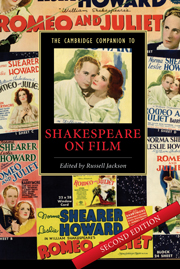Book contents
- Frontmatter
- Introduction: Shakespeare, films and the marketplace
- Part I Adaptation and its Contexts
- Part II Genres and Plays
- 5 The comedies on film
- 6 Filming Shakespeare’s history: three films of Richard III
- 7 Hamlet, Macbeth and King Lear on film
- 8 The tragedies of love on film
- Part III Directors
- Part IV Critical Issues
- Further Reading
- Filmography
- Index
- Series List
8 - The tragedies of love on film
from Part II - Genres and Plays
Published online by Cambridge University Press: 28 July 2007
- Frontmatter
- Introduction: Shakespeare, films and the marketplace
- Part I Adaptation and its Contexts
- Part II Genres and Plays
- 5 The comedies on film
- 6 Filming Shakespeare’s history: three films of Richard III
- 7 Hamlet, Macbeth and King Lear on film
- 8 The tragedies of love on film
- Part III Directors
- Part IV Critical Issues
- Further Reading
- Filmography
- Index
- Series List
Summary
The celluloid fortunes of Shakespeare’s tragedies of love mirror their stage history. Most popular of the three tragedies, Romeo and Juliet has the richest stage history. Shakespeare’s earliest tragedy of love invites an exploration of social issues, survives transpositions of time and place, accommodates multicultural casting and, of course, dramatises the timeless conflict between generations. Although there are numerous important productions of Othello - and memorable portrayals of Othello and his adversary, the script presents greater challenges than does Romeo and Juliet. Contemporary audiences expect, for example, a black actor in the title role and find the racist and sexist language offensive. In the late twentieth century Shakespeare’s study of jealousy in The Winter’s Tale was staged more often than Othello. Least popular of the three tragedies of love, Antony and Cleopatra is also the most demanding to stage or film. Film directors, like their theatrical counterparts, face the challenge of translating English Renaissance play-scripts to a new medium and for a contemporary audience. A particular challenge of the tragedies of love is the limited number of crowd-pulling scenes of bliss and fulfilment, or as in the case of Shakespeare’s mature Othello and Desdemona and to a lesser extent with the adulterous Antony and Cleopatra, face-to-face confrontation and conflict. One focus of this study will be an examination of ways in which film directors open out the plays to provide scenes for the tragic lovers, who would otherwise spend little time with each other.
- Type
- Chapter
- Information
- The Cambridge Companion to Shakespeare on Film , pp. 141 - 164Publisher: Cambridge University PressPrint publication year: 2007
- 2
- Cited by

